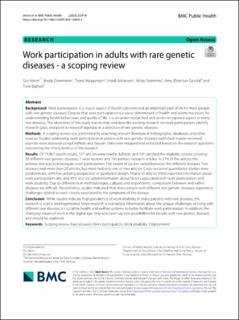| dc.description.abstract | Background Work participation is a crucial aspect of health outcome and an important part of life for most people
with rare genetic diseases. Despite that work participation is a social determinant of health and seems necessary for
understanding health behaviours and quality of life, it is an under-researched and under-recognized aspect in many
rare diseases. The objectives of this study was to map and describe existing research on work participation, identify
research gaps, and point to research agendas in a selection of rare genetic diseases.
Methods A scoping review was performed by searching relevant literature in bibliographic databases and other
sources. Studies addressing work participation in people with rare genetic diseases published in peer reviewed
journals were assessed using EndNote and Rayyan. Data were mapped and extracted based on the research questions
concerning the characteristics of the research.
Results Of 19,867 search results, 571 articles were read in full text, and 141 satisfied the eligibility criteria covering
33 different rare genetic diseases; 7 were reviews and 134 primary research articles. In 21% of the articles the
primary aim was to investigate work participation. The extent of studies varied between the different diseases. Two
diseases had more than 20 articles, but most had only one or two articles. Cross-sectional quantitative studies were
predominant, with few utilizing prospective or qualitative design. Nearly all articles (96%) reported information about
work participation rate, and 45% also included information about factors associated with work participation and
work disability. Due to differences in methodologies, cultures and respondents, comparison between and within
diseases are difficult. Nevertheless, studies indicated that many people with different rare genetic diseases experience
challenges related to work, closely associated to the symptoms of the disease.
Conclusion While studies indicate high prevalence of work disability in many patients with rare diseases, the
research is scarce and fragmented. More research is warranted. Information about the unique challenges of living with
different rare diseases is crucial for health and welfare systems to better facilitate work participation. In addition, the
changing nature of work in the digital age, may also open up new possibilities for people with rare genetic diseases
and should be explored. | en_US |

